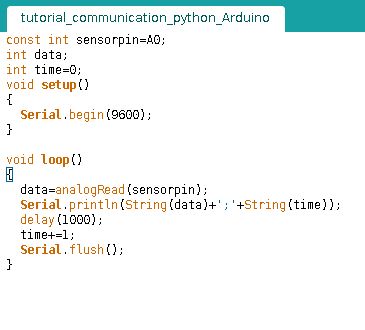

- #PYTHON READ SERIAL DATA FROM ARDUINO HOW TO#
- #PYTHON READ SERIAL DATA FROM ARDUINO INSTALL#
- #PYTHON READ SERIAL DATA FROM ARDUINO UPDATE#
- #PYTHON READ SERIAL DATA FROM ARDUINO CODE#
In the example code below, the arduino simulates a coin toss using the function random. To test my code, I used an Arduino to put some data on the serial port. In addition, I have limited the scope of this post to just sending float and int data types since these 2 data types will be sufficient.
#PYTHON READ SERIAL DATA FROM ARDUINO INSTALL#
Sudo apt-get install python3-serial Generating some fake serial data with an Arduino In this section, we will focus on sending data from the Arduino to the computer over a serial connection, and then plotting it with Python.We will use the data from a potentiometer as an example for the code below since it involves only a simple analogRead(). Installing matplotlib and pyserial on Ubuntu 18 sudo apt-get install python3-matplotlib We can do this with Arduino's Serial. First, we will want a bit of code that will initiate the Ardunio's serial connection, and pass a message along. Arduino (or any programmable device with a serial port) Communicating between the Ardunio and Python is somewhat easier than the other way around.For a proper introduction to Matplotlib, I’d recommend sentdex’s Matplotlib video series. I’m using this page to document my attempt(s) to use Matplotlib to create a real time graph of data read from a serial port. import serial import time connected False writetofilepath 'output.txt' outputfile open (writetofilepath, 'w+') serialport '/dev/ttyACM0' baudrate 9600 ser serial. But it removes old input from the buffer and reads in the new input.
#PYTHON READ SERIAL DATA FROM ARDUINO UPDATE#
As it turns out, Matplotlib includes an animation API and a function called FuncAnimation, which can be used to animate data over time (or update a graph with some sensor data over time). This, on the other hand, works perfectly with the exception of not having a tkinter window. My code allows to obtain CSV as follows: My Arduino code for serial output: Serial.print(sensorValue1) Serial.print(',') Serial. I want to save data in format: time, sensor1, sensor2 as numbers allowing to open them in Excel in separate columns. To test my code, I used an Arduino to put some data on the serial port. I am trying to write serial port data from Arduino to CSV file in Python. A quick search turned up Matplotlib – a MATLAB-like plotting API for Python. Python 3.x Matplotlib pyserial Arduino (or any programmable device with a serial port) Installing matplotlib and pyserial on Ubuntu 18 sudo apt-get install python3-matplotlib sudo apt-get install python3-serial Generating some fake serial data with an Arduino. import tkinter as tk import serial Serial imported for Serial communication import threading Create the master object root tk.Tk () ArduinoSerial serial.Serial ('com5', 9600). Second both sides have to compromise the format of the data. Example reader assuming port is opened with a timeout: while True: data port.readline () Blocks until a complete frame is received or timeout if data: d json. Note that you need to specify a timeout to be able to exit your program as readline () will otherwise block forever. I’ve known for a while that Python has an easy-to-use serial library, but I wasn’t sure what kinds of plotting/graphing options might exist for Python. First you need to do the serial reading in a thread so that it won't block the main application. An ndjson framed stream can be read using pyserial.readline (). While this is a trivial task in MATLAB or LabVIEW, I wondered if there was a low effort way to do it for free. Here is the code (I omitted most part of the code, but the loop is the same): ser = serial.Serial('/dev/ttyUSB0', 2000000, timeout=2, xonxoff=False, rtscts=False, dsrdtr=False) #Tried with and without the last 3 parameters, and also at 1Mbps, same happens.It’s useful to be able to read and plot serial data in real time (for example, you might want to monitor the output of a laser scanner or IMU). When opening the serial port via pySerial I see all messages but instead of receiving 100-150x per second i receive them at about 5 per second (still the message increments 1 by 1) but they are probably stored in some buffer as when I power off the PIC, i can go to the kitchen and come back and im still receiving messages.When opening the serial port via Putty I see all messages (the counter in the message increments 1 by 1).I thought to send some float data from the Arduino first.

On my laptop I have Xubuntu running as virtual machine, I can read the serial port via Putty and via my script (python 2.7 and pySerial) I need to send float data to Arduino from Python and get the same value back.


Im sending messages (size of about 15 chars) about 100-150x times a second and the number there increments (to check if i have messages being lost and so on) The PIC works with perfect timing at 2Mbps, also the FTDI usb-serial port works great at 2Mbps (both verified with oscilloscope)
#PYTHON READ SERIAL DATA FROM ARDUINO HOW TO#
I am using a script in Python to collect data from a PIC microcontroller via serial port at 2Mbps. 1 Python IDLE 1 PySerial Library Project description In this tutorial, we are going to learn how we can install python on our computer and how to use it with Arduino, it allows us to send data between a computer though Arduino's serial.


 0 kommentar(er)
0 kommentar(er)
